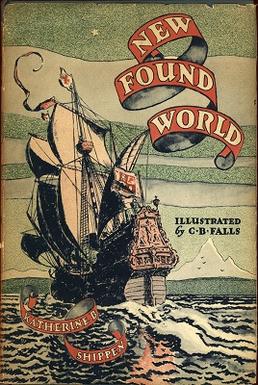New Found World facts for kids
New Found World is an exciting history book for young readers, written by Katherine Binney Shippen and illustrated by Charles Buckles Falls. First published in 1945, this book takes you on a journey through the rich history of Latin America. It explores ancient civilizations like the Aztecs, Mayans, and Incas, and tells the stories of the Conquistadors who arrived from Europe. The book also covers the search for the legendary city of El Dorado, the arrival of Christianity, and the important struggles for independence from European powers. New Found World was recognized for its excellence, receiving a Newbery Honor in 1946.
Contents
Exploring Ancient Civilizations in Latin America
Latin America is home to some of the world's most fascinating ancient civilizations. Before Europeans arrived, powerful empires and advanced societies thrived there. New Found World introduces readers to three of the most famous: the Aztecs, Mayans, and Incas.
The Amazing Aztec Empire
The Aztecs built a powerful empire in what is now central Mexico. Their capital city, Tenochtitlan, was huge and built on an island in a lake. It had impressive temples, markets, and canals. The Aztecs were skilled farmers, warriors, and artists. They had a complex religion and a unique writing system. Their society was well-organized, with a powerful emperor at the top.
The Mysterious Mayan Civilization
The Mayans lived in southern Mexico and Central America. They were known for their incredible achievements in science and art. Mayans developed advanced writing, mathematics, and astronomy. They created a very accurate calendar and built magnificent pyramid temples. Their cities were centers of learning and trade. The Mayan civilization thrived for many centuries before its decline.
The Mighty Inca Empire
The Incas ruled the largest empire in ancient America. It stretched along the Andes Mountains in South America. The Incas were master builders, creating vast road networks and impressive stone cities like Machu Picchu. They had a strong government and a unique system of record-keeping using knotted strings called quipu. The Inca society was very organized, with a focus on community and shared resources.
European Arrival and the Conquistadors
The arrival of Europeans in the late 1400s brought huge changes to Latin America. Explorers and soldiers from Spain and Portugal, known as Conquistadors, came seeking new lands and riches.
Who Were the Conquistadors?
Conquistadors were Spanish and Portuguese explorers and warriors. They played a major role in the European colonization of the Americas. Famous conquistadors include Hernán Cortés, who conquered the Aztecs, and Francisco Pizarro, who conquered the Incas. Their expeditions led to the establishment of vast colonial empires.
The Search for El Dorado
One of the most famous legends that drew conquistadors to South America was the story of El Dorado. This legend spoke of a city or a king covered in gold. Many explorers spent years searching for this mythical place. While El Dorado was never found as a golden city, the legend fueled much exploration and discovery in the region.
Christianity and Colonial Rule
Along with the conquistadors, missionaries arrived to spread Christianity. This led to significant cultural and religious changes across Latin America. European powers established colonies, ruling over the lands and their people.
The Spread of Christianity
Christian missionaries, mainly from Spain and Portugal, worked to convert the native populations. Churches and missions were built throughout the colonies. This process often blended with existing indigenous beliefs, creating unique cultural traditions.
Life Under Colonial Powers
For centuries, Latin American countries were colonies of European nations. Spain controlled most of South America, Central America, and Mexico. Portugal ruled Brazil. During this time, resources were sent back to Europe, and European laws and customs were introduced. This period shaped the languages, religions, and cultures of Latin America.
The Fight for Independence
By the early 1800s, many people in Latin America wanted to be free from European rule. This led to long and difficult struggles for independence.
Why Independence Was Important
People in the colonies felt they were not treated fairly by their European rulers. They wanted to govern themselves and control their own resources. Ideas of freedom and self-determination, inspired by revolutions in North America and France, spread throughout the region.
Key Leaders and Battles
Many brave leaders emerged during the independence movements. Simón Bolívar, known as "The Liberator," helped several South American countries gain freedom. José de San Martín was another key figure in the independence of Argentina, Chile, and Peru. These struggles involved many battles and sacrifices, eventually leading to the creation of independent nations across Latin America.


